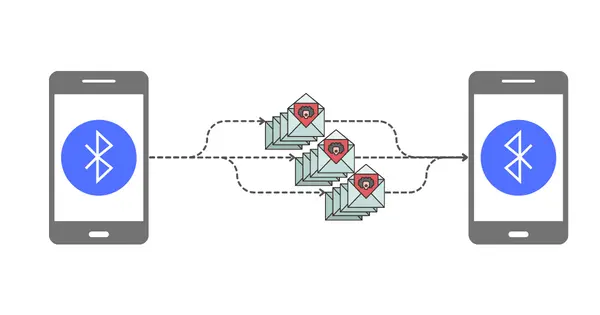🔍 Search
📥 Subscribe
Bluetooth Hacking

Table of Contents
This ethical hacking guide explains what Bluetooth hacking is, how Bluetooth attacks work, types of Bluetooth attacks and its prevention in cyber security.
What is Bluetooth Hacking?
Bluetooth hacking refers to gaining unauthorized access to Bluetooth-enabled devices or data by exploiting vulnerabilities in the Bluetooth protocol.
Bluetooth is a wireless technology that allows the exchange of data over short distances between mobile devices, computers, and other electronic gadgets. Since it is widely used in everyday devices such as smartphones, laptops, and IoT devices, it presents an attractive target for attackers.
The goal of Bluetooth hacking can vary depending on the attacker's motives. For example, an attacker may want to steal sensitive information from a mobile phone, such as contacts, text messages, or passwords. Alternatively, an attacker may want to take control of a device, make unauthorized phone calls, send text messages, or eavesdrop on conversations.
How Bluetooth Attacks Work?
Bluetooth attacks generally exploit weaknesses in the Bluetooth communication protocol, which might include outdated security features, weak encryption, or flaws in the device's Bluetooth software. Attackers often use specialized software tools to intercept or send Bluetooth signals without user permission.
Steps in a Bluetooth Attack:
- Discovery: The attacker scans for discoverable Bluetooth devices within range.
- Connection: Using known vulnerabilities, the attacker attempts to establish a connection with the target device.
- Exploitation: Once connected, the attacker exploits vulnerabilities to carry out malicious actions.
- Data Extraction or Interference: The attacker may steal data, inject malware, or cause the device to malfunction.
Types of Bluetooth Attacks
Depending on the attacker's objectives and the vulnerabilities found, several types of attacks can be launched:
1. BluePrinting Attack
Bluetooth devices can be fingerprinted or probed to collect information using a technique known as BluePrinting.
By using this method an attacker can obtain details about the target device such as manufacturer, model, version etc., which can be further used to find vulnerabilities and exploit them for illegitimate purpose.

2. BlueJacking Attack

Bluejacking is a type of Bluetooth-based attack that involves sending unsolicited messages or data to a nearby Bluetooth-enabled device. To carry out a bluejacking attack, the attacker does not need to pair with the victim's device or have any prior authorization to send the message or file.
Bluejacking is typically harmless and does not involve stealing or manipulating data on the victim's device. Instead, it is often used as a prank or a way to get the victim's attention.
3. BlueSnarfing Attack
Bluesnarfing is a type of Bluetooth attack in which an attacker gains unauthorized access to a Bluetooth-enabled device and accesses sensitive data, such as contacts, messages, photos, videos, and other personal information.
To execute the Bluesnarfing attack, the attacker exploits vulnerabilities in the OBEX (Object Exchange) protocol.
4. BlueBugging Attack
Bluebugging is a type of Bluetooth attack in which an attacker gains unauthorized access to a Bluetooth-enabled device, and takes control of the device to make calls, send messages, or access sensitive data, without the user's consent. In some cases, the attacker can even use the device to install malware or other malicious software.
Bluebugging attacks can be carried out from a distance of up to 100 meters, which means that attackers can target devices from a nearby location without being detected. This makes bluebugging a serious security threat, especially in public places.
Preventing Bluetooth Attacks
There are several steps you can take to prevent bluetooth hacks:
- Keep Bluetooth turned off when not in use
- Use strong passwords or PIN codes
- Use the latest software and security updates
- Pair only with known devices
- Avoid using Bluetooth in public places
- Disable Bluetooth discovery mode
- Use Bluetooth encryption
Summary
While Bluetooth technology offers tremendous convenience, its vulnerabilities can pose significant security risks, especially with the proliferation of Bluetooth-enabled IoT devices. By understanding how Bluetooth attacks work and implementing strong security measures, individuals and businesses can mitigate the risk of Bluetooth hacks and protect sensitive information from malicious actors.
